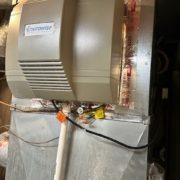Guide to Furnace-Mounted Humidifiers
Dry air is a common problem during colder winter months. It can lead to dry skin, irritated eyes, sore throats, and increased susceptibility to colds and flu. A whole-house humidifier mounted directly to your furnace is an excellent solution to combat these issues and improve comfort.
As HVAC technicians, we get a lot of questions about furnace-mounted humidifiers. So, we thought we would answer some of the most common ones:
Why Install a Furnace-Mounted Humidifier?
Whole-house coverage: Unlike portable humidifiers, which only work in a single room, a furnace-mounted unit humidifies your entire home evenly.
Convenient: These humidifiers are integrated with your HVAC system, automatically adjusting humidity levels based on your thermostat settings.
Efficient: They use your furnace blower to distribute moisture, making them more energy-efficient than standalone units.
No extra space required: Mounted on your furnace, they are discreet and don’t take up valuable living space.
How Does a Humidifier Work?
A furnace-mounted humidifier uses a water panel or drum to introduce moisture into the warm air circulated by your furnace.
Water Supply: A water line connects the humidifier to your plumbing.
Evaporation: Water flows over the panel or drum and evaporates into the air, passing through the duct.
Distribution: The furnace blower circulates the humidified air throughout your home.
Humidistat Control: A humidistat monitors the humidity level and signals the humidifier to turn on or off as needed.
What to Expect During Installation
This is the process we execute during our professional installation.
Choosing the right location: The humidifier is typically installed on the warm air supply plenum (the large duct coming out of your furnace).
Water line connection: A saddle valve or dedicated water line taps into your home’s water supply.
Electrical connection: The humidifier must be wired to your furnace’s control board for power and humidity control.
Bypass duct installation: Some models require a bypass duct for proper airflow and humidity control.
Humidistat mounting: The humidistat is usually mounted on a wall in a central location.
Other Considerations for a Homeowner
Water quality: Hard water can cause mineral buildup and affect the humidifier’s performance. Consider a water-softening solution or a humidifier with a self-cleaning feature.
Maintenance: Regular maintenance is crucial and includes changing the water panel or, cleaning the drum, checking the water line for leaks, and cleaning or replacing the air filter.
Professional installation: While DIY installation is possible, hiring a qualified HVAC technician is best to ensure proper installation and avoid potential issues.
More Benefits from a Furnace-mounted Humidifier
Protects your home. Proper humidity levels help prevent wood furniture and flooring from drying out and cracking.
Reduces static electricity. You can say goodbye to those annoying shocks!
It may help with allergies. Proper humidity can help reduce dust and other allergens in the air.
Do you want to be more comfortable indoors this winter?
If you’re tired of dry air and its effects, a furnace-mounted humidifier is a worthwhile investment. Contact Steve’s Heating and Cooling, Kansas City’s trusted HVAC professionals, to discuss your options and get a quote for installation and maintenance.







